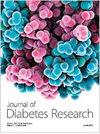The Effect of Canagliflozin on High-Density Lipoprotein Cholesterol and Angiopoietin-Like Protein 3 in Type 2 Diabetes Mellitus
IF 3.4
3区 医学
Q2 ENDOCRINOLOGY & METABOLISM
引用次数: 0
Abstract
Background. Diabetes mellitus is often accompanied by dyslipidemia. Sodium-glucose cotransporter-2 (SGLT2) inhibitors, as a novel therapeutic agent for the treatment of type 2 diabetes mellitus (T2DM), have been reported to exert effects on lipid, while the results remain controversial. This study is aimed at exploring the effect of SGLT2 inhibitor canagliflozin on lipid profile. Methods. This study was a single-center, open-label, nonrandomized, prospective study. Metformin (500 mg three times per day) or canagliflozin (100 mg, once daily) was administered for 12 weeks. Fasting blood samples were collected before and 12 weeks after treatment. Serum lipid profile levels and angiopoietin-like protein 3 (ANGPTL3) were determined. In animal experiment, C57BL/6 J mice were divided into three groups including control, STZ + HFD, and STZ + HFD + canagliflozin. Lipid profile and plasma ANGPTL3 level were measured after 12 week’s treatment. Moreover, the expression of ANGPTL3 was detected in the liver tissues. Results. There was a decreased trend in low-density lipoprotein cholesterol (LDL-c) and triglycerides (TG) after canagliflozin treatment, while canagliflozin significantly increased high-density lipoprotein cholesterol (HDL-c) level and decreased plasma ANGPTL3 level. In addition, the expression of ANGPTL3 in liver tissues decreased obviously in diabetic mice with canagliflozin treatment. Conclusions. Canagliflozin increases HDL-c level and suppresses ANGPTL3 expression in patients with T2DM and diabetic mice. The reduction of ANGPTL3 may contribute to the increase of HDL-c. However, the specific mechanism needs further research. This trial is registered with ChiCTR1900021231.卡格列净对 2 型糖尿病患者高密度脂蛋白胆固醇和血管生成素样蛋白 3 的影响
背景。糖尿病通常伴有血脂异常。钠-葡萄糖共转运体-2(SGLT2)抑制剂作为治疗 2 型糖尿病(T2DM)的新型治疗药物,据报道对血脂有影响,但结果仍存在争议。本研究旨在探讨 SGLT2 抑制剂卡格列净对血脂的影响。研究方法本研究是一项单中心、开放标签、非随机、前瞻性研究。二甲双胍(500 毫克,每天三次)或卡格列净(100 毫克,每天一次)用药 12 周。在治疗前和治疗 12 周后收集空腹血样。测定血清脂质概况水平和血管生成素样蛋白 3(ANGPTL3)。在动物实验中,C57BL/6 J小鼠被分为三组,包括对照组、STZ + HFD组和STZ + HFD + canagliflozin组。治疗12周后测定血脂和血浆ANGPTL3水平。此外,还检测了ANGPTL3在肝组织中的表达。结果显示卡格列净治疗后,低密度脂蛋白胆固醇(LDL-c)和甘油三酯(TG)呈下降趋势,而卡格列净能显著提高高密度脂蛋白胆固醇(HDL-c)水平,降低血浆ANGPTL3水平。此外,卡格列净治疗后,糖尿病小鼠肝组织中ANGPTL3的表达明显减少。结论卡格列净可提高T2DM患者和糖尿病小鼠的HDL-c水平,抑制ANGPTL3的表达。ANGPTL3 的减少可能有助于 HDL-c 的增加。然而,具体机制还需要进一步研究。本试验注册号为 ChiCTR1900021231。
本文章由计算机程序翻译,如有差异,请以英文原文为准。
求助全文
约1分钟内获得全文
求助全文
来源期刊

Journal of Diabetes Research
ENDOCRINOLOGY & METABOLISM-MEDICINE, RESEARCH & EXPERIMENTAL
CiteScore
8.40
自引率
2.30%
发文量
152
审稿时长
14 weeks
期刊介绍:
Journal of Diabetes Research is a peer-reviewed, Open Access journal that publishes research articles, review articles, and clinical studies related to type 1 and type 2 diabetes. The journal welcomes submissions focusing on the epidemiology, etiology, pathogenesis, management, and prevention of diabetes, as well as associated complications, such as diabetic retinopathy, neuropathy and nephropathy.
 求助内容:
求助内容: 应助结果提醒方式:
应助结果提醒方式:


